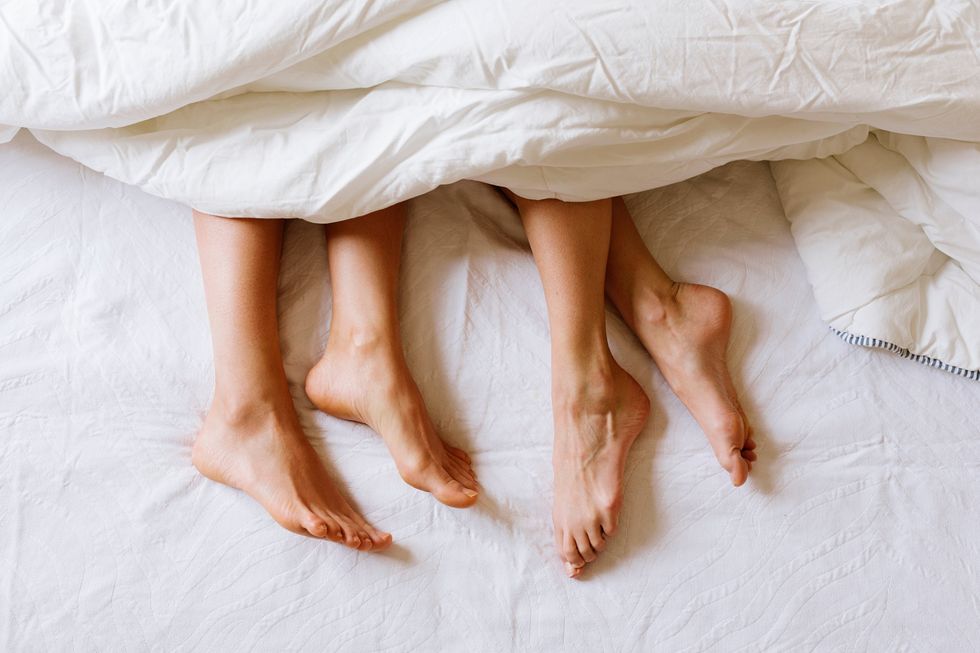You’ve probably heard someone mention anal fissures at some point in your life...

Shutterstock
...and if you’re a bottom, you may very well have already had them.
So what exactly are they? Anal fissures are small tears in the thin, moist tissue (mucosa) that lines your anus. Most (straight) people get them from very large bowel movements. But if you’re a bottom, you’re at a higher risk for them, especially if your partner is a power driller who uses his large tool tactlessly.
“While anal fissures are often associated with anal sex, they’re not exclusive to gay men,” Dr. Evan Goldstein, the leading anal health expert in the United States, tells PRIDE. “In fact, a large portion of the general population will experience either a fissure or hemorrhoid at some point in their lives. That said, among my gay male patients, fissures are one of the most common issues I treat—often tied to the mechanics and frequency of bottoming.”
Anal fissures can be incredibly painful. They can cause bleeding after you poop (and after sex). They will also randomly itch throughout the day. It’s an awkward bodily sensation to have something inside you that’s both itchy and painful. It can hurt to sneeze, laugh, walk, sit, and poop if they get really irritated.
So, here are 12 things you need to know about getting, preventing, and healing anal fissures, according to Dr. Goldstein, who has spent his entire career providing care to the gay community, and last year wrote Butt Seriously: The Definitive Guide to Anal Health, Pleasure, and Everything In Between.
1. Keep your bowel movements loose

Constipation is an anal fissure's worst enemy. The pushing and pressure from constipation can cause tears in your mucosa and rip the tears you already have further open. Make sure to stay hydrated and eat tons of fiber to avoid constipation. If that’s not enough, try over-the-counter laxatives and stool softeners.
“Over-the-counter options, like stool softeners (e.g., Colace, taken 3x/day), fiber supplements (like Metamucil), and Calmol-4 suppositories (2x/day, available at most local pharmacies) can be incredibly helpful, as well as plenty of water to supplement,” Dr. Goldstein recommends. “These form a solid foundation for at-home care, especially for individuals without immediate access to specialized treatment.”
2. Eat more olive oil

Shutterstock
As with staying hydrated and eating more fiber to help keep your bowel movements loose, consider adding more olive oil to your daily intake, as well. This is a natural laxative to help you pass your stool. Additionally, mixing in a little honey and beeswax, then heating up the mixture and letting it cool, can also be used as a topical.
According to Dr. Goldstein, eating a high fiber diet full of grains, fruits, vegetables, legumes, and seeds, plus plenty of water, “supports consistent, soft bowel movements and overall gut health” and “ adding healthy fats, like olive oil, can also help lubricate the digestive tract.”
3. Don’t hold in your poops

When you hold in a bowel movement, it will eventually come out, and when it does, it comes out more intensely, packing an even stronger punch. This can agitate the tissue and cause additional tears.
“While the healing process takes time and every bowel movement can feel like a setback, avoiding them can make things worse. Don’t hold it in; just be patient. Use stool softeners or fiber supplements regularly,” he explains.
Dr. Goldstein, who is the CEO of Bespoke Surgical and co-founder of Future Method (the first scientific, holistic, and educational brand devoted to supporting safe, healthy, and judgment-free pleasure), recommends taking two fiber capsules at night and two synbiotics every morning to help keep things moving and prevent future fissures once you’ve healed.
“It’s important to stay well-hydrated, avoid prolonged sitting on the toilet, and never strain if the urge isn’t there,” he says.
4. Make friends with aloe vera

Shutterstock
Aloe vera is a natural ingredient that helps cool and soothe the affected areas. If you can’t find an aloe plant on your own, buy some organic gel from the store and repeat every three to four hours as needed.
However, Dr. Goldstein warns that aloe should only be used immediately after a fissure occurs, before switching to other treatments that will work better in the long term. “Aloe can definitely be part of the initial care routine, but realistically, after the first 3 to 5 days of using creams or oils, the goal is to keep the area as dry as possible,” he says. “If you’re reaching for aloe, you might be better off using creams specifically designed for anal fissures instead.”
5. Use more lube during sex than you thought possible

Douse yourself in lube. Bathe in it. Dunk his whole penis in a vat of it. Lube makes his penis more slippery, which helps prevent fissures (or allows them to heal). When you have dry sex, your anus will be irritated even more.
“It’s not just about lubrication; it’s also about understanding your own anal anatomy,” Dr. Goldstein explains. “How are your muscles functioning? What’s the condition of your skin? Many people incorporate anal dilation – using dilators or cones – to help relax the muscles, improve function, and strengthen the overlying skin. Since fissures result from pressure, the goal is to reduce that pressure with plenty of lube and by training the area to better tolerate stress.”
6. Soak in a hot bath

Shutterstock Creative
As if you need another excuse to lounge about in the bath, doing so will also help you with your anal fissures. Soaking in warm water for 10 to 20 minutes a day helps relax the sphincter, thus promoting healing.
“Soaking in a warm bath, especially with Epsom salts, can help relax the anal sphincter, soothe inflammation, and promote blood flow to support healing,” he says.
7. Cool it with the bottoming for a little bit

Alas, you may have to stop bottoming for a bit until the tissue has time to heal. Even if you’re doing everything right, the constant pressure and friction from being penetrated, even when heavily lubed, will prevent the fissures from healing properly. If you do have sex, be gentle. Nice and easy.
Dr. Goldstein cautions that it’s important to spend a week using creams and suppositories to start the healing process, followed by a second week of no sex. “It’s a process, but if you go slow and do it right, the area can heal properly and reduce the risk of it happening again. Skip that step, and you risk developing scar tissue that might eventually require surgery to get you back in action,” he explains.
8. Give Botox a try, it's for more than just wrinkles

shutterstock creative
While you may think butt plugs would be a go-to treatment for loosening yourself back up while healing a fissure, but Dr. Goldstein says they can actually do more harm than good.
“Butt plugs actually put more and more pressure right at the neck of the ass where the thin part to the toy is. So, it actually does nothing to work the muscle and skin to decrease pressure. It can also increase swelling that causes hemorrhoids and fissures when pulling the fucking thing out.”
Botox, on the other hand, can be a game-changer. “It works by temporarily relaxing the anal muscles to reduce pressure and allow healing,” he says. “It typically lasts three to four months. Most patients benefit from two to three in-office rounds, paired with at-home dilation and pelvic floor therapy to reinforce the reset.”
9. Preparation H

Jenari/Shutterstock
The #1 doctor-recommended, over-the-counter medication for treating fissures (and hemorrhoids). Preparation H makes a number of products for all your anal needs. They make ointments, maximum pain relief creams, cooling gels, suppositories, medicated wipes, and anti-itch creams. (Important note: this is only a temporary fix, and please don't apply it on open wounds!
“You can absolutely grab this if you are experiencing mild symptoms or just need something in a pinch. It can work to help heal and soothe,” Dr. Goldstein says.
10. AnuSol Cream

Shutterstock Creative
Another over-the-counter medication, AnuSol Cream is an additional tool you should have in your toolbox to help treat anal fissures. Some men have better luck with it than they do with Preparation H. Again, this is only a temporary fix, and don't apply it on open wounds!
“Apply a pea-sized amount at night, in the morning, and after bowel movements as directed by your provider. This, plus Calmol-4 suppositories or similar, can really help,” Dr. Goldstein recommends. “I like dipping the suppository into the cream before putting it up your ass before bed and/or after bowel movements. This can really help more so with going to the bathroom. That’s the key – soft stools, less pressure and straining, and lubrication so you don’t tear. All this together helps the fissure to heal.”
11. Rectiv Rectal

Rectiv Rectal is a medication you can only get prescribed from your doctor. It’s an ointment, very similar in texture to Neosporin. You insert a dab into your anus every 12 hours. It helps to heal the ripped tissue with its magical, medical powers.
“I find many get headaches from it since it works not just locally in the ass,” Dr. Goldstein warns, but says, “it's covered by insurance, so many people try that first and see if it can be tolerated. It helps relax the muscles. I also use a lot of Valium suppositories to also relax the region, which allows for healing and then bottoming.”
12. If all else fails…surgery

Shutterstock Creative
If you’ve tried everything on this list and are still suffering, it may be time to look into more serious forms of intervention. “When a fissure has progressed to scarring or excess tissue, Botox alone won’t cut it,” Dr. Goldstein says. “Many people come to me after failed treatments elsewhere. In those cases, we often need to surgically remove the scar tissue to rebuild the area with healthy, pliable skin. Then we reintroduce dilation and physical therapy to maintain long-term success.”













































































